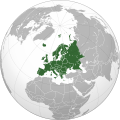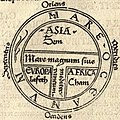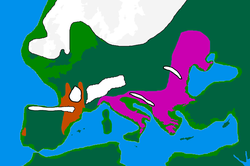Europe


Europe is the western part of the continent of Eurasia, often thought of as its own continent. It is separated from Asia by the Ural Mountains in Russia and the Bosporus strait in Turkey.
Europe is bordered by water on three sides. On the west is the Atlantic Ocean. To the north is the Arctic Ocean. The Mediterranean Sea separates Southeastern Europe from the continent of Africa. On the eastern border of Europe are the Ural River and Ural Mountains.
There are at least 44 or 50 countries in Europe (the European identities of 7 countries: Armenia, Azerbaijan, Cyprus, Georgia, Kazakhstan, Russia and Turkey are disputed). Most of these countries are members of the European Union.
Europe covers about 10,180,000 square kilometre (3,930,000 square miles). This is 2% of the Earth's surface (6.8% of its land area).
As of 2017, about 510 million people lived in Europe.[1]
Europe contains the world's second most-active volcano, which is Mount Etna that is currently the most-active volcano in the continent.
Europe is a major tourist attraction. People come from all over the world to see its many World Heritage Sites and other attractions. The continent has the largest Roma population in the world.[2]
Origin of name
Europe is named after a princess in Greek mythology called "Europa." The myth says that Zeus kidnapped Europa and took her to Crete, where she became the mother of King Minos (from whom Europe’s first civilization gets its name, the Minoans).
The name "Europa" was later used to describe Greece. Then, as the rest of modern-day Europe started to have cities and empires, the entire area West of the Ural Mountains came to be called "Europa".
History
The history of Europe is long and has many turns. Many great countries originated from Europe. Greek mythology and the beginning of western civilization came from European nations.
Some of the major periods in European history have been:
- Ancient Greece (Minoan, Mycenaean, Archaic, Classical, Hellenistic): c.2000 BC to 146 BC
- Ancient Rome (Roman kingdom, Roman Republic and Roman Empire): 753BC-476
- Middle Ages (Early, High, Late): 476 to 1492
- Early Modern Era (Renaissance, Reformation, Age of Discovery, Enlightenment): 1492-1789
- 19th Century, 20th Century and 21st Century (French Revolution, Napoleonic Wars, Industrial Revolution, Colonialism, World War 1, October Revolution, World War 2, Cold War): 1789-present.
Regions and countries
Andreas M. Kaplan describes modern Europe as a continent where many different cultures live closely together, "embracing maximum cultural diversity at minimal geographical distances".[3]
There are several major regions of Europe:
Within these regions, there are up to 50 independent European countries (with the identities of 7 transcontinental countries being disputed). The largest is the Russian Federation, which covers 39% of Europe.
The largest cities in Europe are Istanbul, Moscow, London, St. Petersburg and Berlin. The country with the largest population is the Russian Federation. About 15% of Europeans live in Russia.
Two European countries, the United Kingdom and the Republic of Ireland, are on islands called the British Isles.
Climate
Most of Europe lies in temperate climate zones.
However, there are many different climates throughout Europe. For example, during the winter, it may be snowing and -30 degrees Celsius for 4–5 months in the north of Europe. Yet it may be much warmer, with no snow at all except on high mountains, in Spain.
European organizations
- European Union
- Council of Europe
- European Court of Human Rights
- Union of European Football Associations
- Warsaw Pact Organization (1955-1989)
European Union
The European Union is a confederation of 27 European countries. These countries agree to follow common laws so that their citizens can move and trade in EU countries almost the same as they do in their own. Twenty of these countries also share the same type of money: the euro.
Europe Media
Reconstruction of an early world map made by Anaximander of the 6th century BCE, dividing the known world into three large landmasses, one of which was named Europe
A medieval T and O map printed by Günther Zainer in 1472, showing the three continents as domains of the sons of Noah – Asia to Sem (Shem), Europe to Iafeth (Japheth) and Africa to Cham (Ham)
Last Glacial Maximum refugia, c. 20,000 years ago* Solutrean culture* Epigravettian culture
References
| Wikimedia Commons has media related to Lua error in Module:Commons_link at line 62: attempt to index field 'wikibase' (a nil value).. |
- ↑ "World Populations Prospects, the 2015 RevisionS Archived 2016-09-27 at the Wayback Machine". United Nations - Department of Economic and Social Affairs - Population Division.
- ↑ https://multimedia.europarl.europa.eu/en/topic/romani-people-in-the-eu_20901.
{{cite web}}: Missing or empty|title=(help) - ↑ "Andreas M. Kaplan: European Management and European Business Schools: Insights from the History of Business Schools, European Management Journal, 2014". European Management Journal. doi:10.1016/j.emj.2014.03.006. ISSN 0263-2373. Archived from the original on 2021-05-21. Retrieved 2017-08-31.









